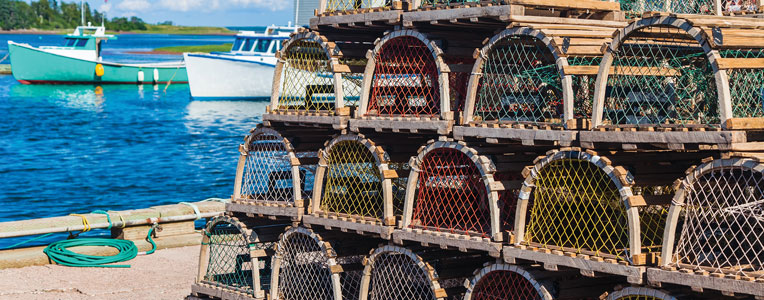
Step on an elevator anywhere on the East Coast and whoever is inside will say hello — family, friend or perfect stranger. Inevitably they will comment on the weather. Connecting with those in the community is part of the fabric of life in the four provinces that comprise Atlantic Canada.

Step on an elevator anywhere on the East Coast and whoever is inside will say hello — family, friend or perfect stranger. Inevitably they will comment on the weather. Connecting with those in the community is part of the fabric of life in the four provinces that comprise Atlantic Canada.
That friendliness and warmth also distinguishes the legal community from the rest of the country. It’s a matter of degree. It’s not that other areas of the country aren’t collegial, it’s that the profession is not as cordial as it is on the East Coast. “The community here is very close-knit,” says Cheryl Hodder, a partner and vice-chair of the board of directors with McInnes Cooper in Halifax.
Size is one factor that accounts for the closeness. “The legal community in Atlantic Canada remains relatively small, which helps foster a sense of collegiality. It means that many of the lawyers you deal with on the other side of a deal or case are often the same lawyers you encounter in the community, whether through board or charity work or recreational activities,” says Lydia Bugden, CEO and managing partner of Stewart McKelvey in Halifax.
“This is particularly true in some of the smaller communities,” she notes, “but is also true even in larger centres like Halifax or St. John’s.”
Hodder points out that there is a shared expectation that lawyers in the region will give back, a practice that makes them both visible to one another and allies outside a courtroom. “The community really cares about each other. We are strong competitors, but it is a caring community.”
Undoubtedly there are differences between Prince Edward Island, Canada’s smallest province; Newfoundland and Labrador, Canada’s youngest province; Nova Scotia, the region’s most populous province; and New Brunswick, Canada’s only bilingual province. The sense of connection, of being in this together, may be most strongly felt and exemplified in Newfoundland and Labrador.

“There is a subtle but powerful thread running through all interaction which is noticeably different. I describe it as a kind of global sense of familiarity, even when you have no knowledge of the person you are dealing with at all,” says Mark Gruchy, an associate with Gittens & Associates in St. John’s.
For lawyers, he notes, all the basic ways of engaging with each other are designed to promote and foster that sense of connection. “The practical impact is, if one is familiar with the rhythm, you can talk to anybody exactly the same way in a casual sense, conveying a heck of a lot of information with relatively few words.”
He points to the response from the Minister of Justice Andrew Parsons, a lawyer, when unexpectedly informed by media that the government was being sued for defamation by another lawyer in the community. “Yes b’y,” he said with a nod.
Hodder is quick to note, however, that mutual support and respect are not synonymous with a lack of sophistication or legal acumen. Indeed, the reverse is true, she notes. “There are world-class lawyers in Atlantic Canada.”
Three regional firms dominate the market — Stewart McKelvey, McInnes Cooper and Cox & Palmer — and they all have offices in each Atlantic province. There are no “national” firms east of Montreal that cover the region, says Bugden. “I think, as a region, we tend to punch above our weight in demonstrating leadership within the profession and the kind of client work we undertake given the difference in the size of markets.”
She notes that changes in practice areas often track along with advances and vagaries in society generally. “For example, changes to our country’s demographics have resulted in a surge in the practice area of immigration. Similarly, the legalization of cannabis has spawned new opportunities for businesses and new areas in the law of regulated industries and dealing with the complexities it introduces in the workplace. Advances in health sciences and technology have driven the need for lawyers to develop practices aligned with those changes, for example, the emergence of fertility law.”
There is also a large start-up community in Halifax, and to a lesser extent in New Brunswick and Newfoundland and Labrador. “Firms are focused on providing services to startups with the hope you will continue with them as they go through their stages of growth,” says Hodder.
Smaller firms are also doing well within their practice areas, both legal and geographical. Gruchy notes that in the 12 years he has been with Gittens & Associates, the firm has grown each year, most recently from nine to 14 lawyers.

The nature of practice has changed, as well. When Gruchy, a criminal lawyer, first started out, it was unusual to do an armed robbery trial. That is no longer the case. “The problems are going to persist and perhaps worsen,” says Gruchy. “It’s a case of how stable the inner bonds of society are. I now have cases with teenagers committing armed robbery. I’ve never seen that in my entire life in Newfoundland.”
The region is both struggling and thriving economically. In its most recent “Provincial Outlook” report published in December 2018, RBC Economic Research forecasts that New Brunswick, which enjoyed stronger-than-expected growth in 2018, will slow its pace to 0.7 per cent in both 2019 and 2020, down from 1 per cent last year. Nova Scotia is expected to experience steady growth over the next two years: 0.8 per cent in both 2019 and 2020, unchanged from 2018.
Prince Edward Island continues to lead the region. In 2017, GDP grew by 3.5 per cent and last year by 1.4 per cent. In the next two years, those numbers are expected to be 1.6 per cent and 1.2 per cent. Meanwhile, Newfoundland and Labrador will pivot from having the bleakest economic performance among the Atlantic provinces in 2018 to the highest in 2019. RBC predicted its gross domestic product would dip by 1 per cent in 2018 and hit 2.3 per cent in 2019. Oil is driving the divergence.
The legal market reflects the larger provincial pictures. In the past two decades, there has been a shift in the “economic order,” says Bugden. This was initially driven by the development of oil and gas, and renewable energy. Now there is greater focus on start-ups, information technology, including cryptocurrency/fintech, network and internet security and privacy, and public and private partnerships as a model for infrastructure projects. “We see more legal business come from outside the market as national and international firms move in related to those sectors,” Bugden says. “Similarly, we’ve seen Atlantic Canadian businesses expand outside this region, and that can also drive new business for law firms.”
For young lawyers, the landscape is perhaps more positive than elsewhere. “There is no articling crisis here as in other parts of the country,” says Gruchy. In fact, a proposal for the first Faculty of Law at Memorial University has now been endorsed by the university’s senate.
The call to come home is still felt by lawyers practising in other provinces. “We continue to see lawyers who grew up in the Atlantic provinces, but started their legal careers in Toronto or Calgary, return home to work,” says Bugden. “Generally, that happens once they’ve acquired two to four years of practice experience, which also makes them interesting to local firms. The market is generally tight across the region for associates with that level of experience.”
She notes that there is a shared landscape with the rest of the country. “We see a decline in the number of practitioners in rural areas, exacerbating access-to-justice issues. We have seen an increase in the number of lawyers hired by some of the large accounting firms as they look to expand their services outside of traditional accounting. Similarly, the need for lawyers to embrace technology to help them innovate the way they work is a challenge for a profession steeped in precedent and tradition.”
One of the appeals of practising in the East Coast is undoubtedly lifestyle. “Nobody is [regularly] spending 18 or 19 hours a day in their office, which is attractive to younger lawyers,” says Hodder. “We work hard, but when we leave the office, amenities are close at hand.”
The cottage can be within an hour’s drive, often less. The pub (and Tim Horton’s) is within walking distance, and hiking trails, theatres, museums and more are usually only a 30-minute drive away, or less. Count on running into another member of the bar while you’re out and about. You may even sit down and enjoy a Moosehead together.
127 - Number of lawyers called to the bar in 2018
2,043 - Number of practising lawyers (as of Dec. 10, 2018)
257 - Number of retired lawyers (as of Dec. 10, 2018)
394 - Number of law firms in the province (including private practice and solo practitioners)
138 - Number of law firms with two or more lawyers
256 - Number of sole proprietorships
96.4 - Percentage of firms in the province with 10 or fewer lawyers (including solo practitioners)
89.9 - Percentage of firms in the province with 10 or fewer lawyers (excluding solo practitioners)
1.01 - Percentage of firms with 50 or more lawyers (4/394)
1,345 - Number of lawyers in private practice
Source: Lawyers’ Insurance Association of Nova Scotia
New Brunswick
87 - Number of lawyers called to the bar in 2018 (49 female, 38 male)
1,370 - Number of practising lawyers (571 female, 799 male)
218 - Number of retired lawyers
398 - Approximate number of law firms in the province
98.7 - Percentage of firms in the province with 10 or fewer lawyers (approx. 309 sole practitioners and 84 firms with two to 10 lawyers)
0.5 - Percentage of firms with 50 or more lawyers (two firms)
882 - Number of lawyers in private practice
335 - Number of lawyers in the largest age group of lawyers (31-40)
183 - Number of female lawyers in the largest age group of female lawyers (31-40)
195 - Number of male lawyers in the largest age group of male lawyers (61-70)
Source: Law Society of New Brunswick
Newfoundland and Labrador
39 - Number of lawyers called to the bar in 2018 (20 male, 19 female)
776 - Number of practising lawyers (446 male, 330 female)
132 - Number of law firms in the province
93 - Percentage of firms in the province with 10 or fewer lawyers
0- Percentage of firms with 50 or more lawyers
485 - Number of lawyers in private practice
131 - Number of lawyers in the largest age group of lawyers (45-49)
Source: The Law Society of Newfoundland and Labrador
*Numbers not available for Prince Edward Island